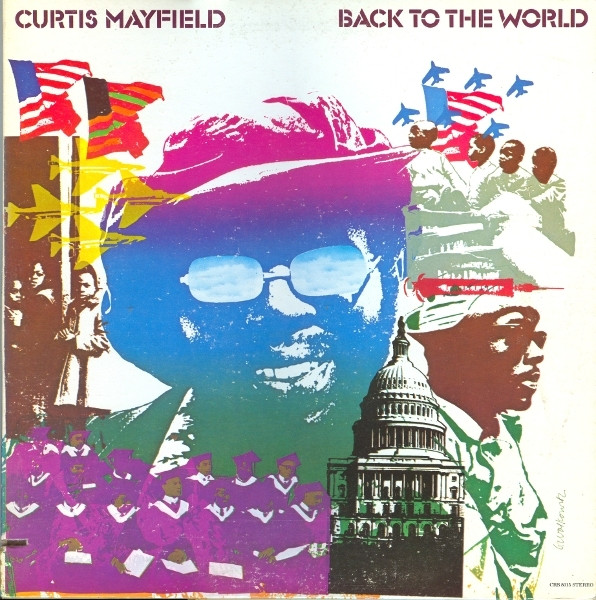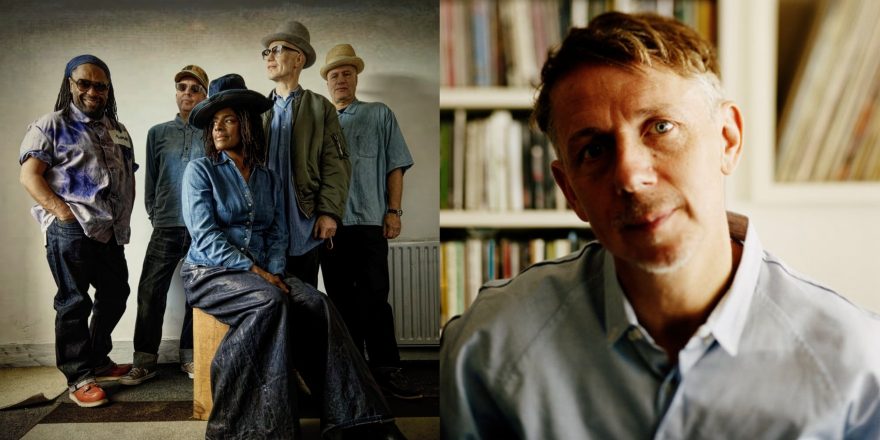Gilles Peterson is a DJ, a BBC Radio host, and the co-founder of the legendary label Acid Jazz Records; Rob Gallagher is a songwriter and DJ whose band Galliano was the first signed to Acid Jazz. Galliano’s first record in almost three decades, Halfway Somewhere, was just released this summer. To celebrate the occasion, the two longtime friends and collaborators met up at Gilles’s to catch up about it all.
— Annie Fell, Editor-in-chief, Talkhouse Music
Gilles Peterson: I want to start off by asking you, Rob, where you got this coffee from today. Because to be honest with you, that’s not a long black.
Rob Gallagher: That is a valid creative question. But I got it because — did you get new shoes, by the way?
Gilles: No, actually. They’re the wrong shoes for these trousers.
Rob: Well, luckily this isn’t a visual medium.
Gilles: I had literally three hours sleep last night because we got in from Catania, where we did the Ricci [Weekender festival] — which you weren’t at this year, but everyone says hello to you. In fact, I had two copies of your record with me, and I gave one to my driver. Do you remember the time that we went to Ricci, the driver that we had? This is a brilliant one — so, the festival is a four day weekender in Catania, and it’s in different spaces and we have chefs and DJs and live bands. We always finish on the Sunday at Radicepura, which is this kind of massive Kew Gardens type of place that sells exotic trees to shopping centers in Dubai. But they have a public space with gardens and little mazes and stuff, and on the Sunday we do our final gig there. And so I remember that year [that you played], this guy picked us up at the airport — lovely Italian guy in his early 20s — you know, holiday job. He’d been really lovely all weekend, taking us to all the different venues. Then on Sunday, the final day, a bunch of us go for a walk in this maze and look at all the different exotic plants.
Rob: And there’s 20 of us now.
Gilles: Group of 20 walking around. And suddenly, [we get to] one of the little areas where there’s almost like a roundabout, where you can take different directions — quite a central point in the maze — and there was a bench there, and on this bench, there’s two people having absolute full-on sex. [Laughs.] Hardcore stuff.
Rob: [Laughs.] But you had to go in the maze a little bit, so they probably didn’t expect 20 people.
Gilles: So we’re walking through and there’s these people having just banging sex. We were like, “Well, that’s quite funny.” We were trying not to look, but everyone was looking.
Rob: But you had to walk past. That’s the point — you couldn’t go back because it’s a maze. You had to keep going.
Gilles: And then eventually, we turned around, and who was it?
Rob: The driver!
Gilles: The driver.
Rob: So you gave him the album?
Gilles: No, that was a different driver.
Rob: [Laughs.] Why tell the story if it’s a different driver?
Gilles: [Laughs.] I said, “I’m not having him back next year. That’s it.” So we’ve got the new driver who’s called Marco. This is a good tip for DJs, artists, anyone: when you go to a place and you get picked up, that person who’s either maybe an artist liaison or your driver, they are usually far better at their craft than you are. The guy I had this year who was driving — he’s just about to go to Sorbonne University in Paris to do advanced music theory.
Rob: And he’s making a little bit of money driving you around.
Gilles: Yeah. He was a super deep guy, and he’s 23 or something. I had the record and I said, “I’ve got the new Galliano.” And he was genuinely excited — which is the first person under the age of 45 that I’ve actually felt that from so far. Which tells us that this is going in the right direction. There’s a new audience picking it up. And as you know, Rob, from your shows that you’ve done at the record shops — you said the demographic was pretty good, right? It wasn’t just Acid Jazz retirement home.
Rob: Well, that’s what we’re building. Virtually, and I think very soon, physically.
Gilles: Why did you copy my style of glasses when you got yours?
Rob: That’s not very creative. I didn’t copy. Everything’s a version of everything.
Gilles: But you were looking at mine. Clearly you were.
Rob: Can you do anything original in 2024?
Gilles: Well, you could have got a more original pair of glasses, that’s for sure.
Rob: I mean, if you think of glasses, though — you can fiddle with the color, you can fiddle with the size, you can fiddle with details. But pretty much they’re going to fall into some parameters. So, copy schmopy.
Gilles: Ask me a question.
Rob: You’re going to have a significant birthday very soon.
Gilles: Yeah, two weeks time. And I’m not doing anything because — well, first of all, I did mention that I was going to be this age to a couple of people in in Italy last week, and both of them said it would be vulgar for me to celebrate it. You should never celebrate on an even. I got it from two very different people — “don’t do it when it’s so obvious.” And I kind of agree with that. But the conversation went to the fact that my radio show, the show I do live on the BBC, lands on my birthday. And then there was quite a lot of talk about what I was going to do. I’ve decided that rather than playing the amount of records that my birthday is — which would be quite a significant chunk of music in the space of three hours — I decided I don’t want to have any shine on it. I just want to just do a normal show, rather than have everyone know about it. Because if you’re in America and you’re a DJ, they’ll use their birthday to put on a party. Every DJ in America will be like, “Yo, it’s my birthday next week,” and that’s an extra additional selling point. It’s not an English thing.
Rob: I’ve had a metaphysical thought about time: I think it’s alright [to celebrate an even-numbered birthday], because when you’re born, that is your 0 birthday. Then after 12 months, you celebrate your first birthday.
Gilles: It’s actually your second.
Robs: Exactly.
Gilles: So I’m 61 this year.
Rob: So, therefore, it’s totally arbitrary whatever frame you celebrate.
Gilles: You asked me about it because it’s obviously dominated—
Rob: No, I didn’t ask you about that. You created the question and answered it, which is very politician.
Gilles: What record in this room right now is speaking to you, from a sleeve point of view? Have a look around. I know which one you’re going to say.
Rob: Oh really?
Gilles: I assume it’s that one. [Gilles points to Curtis Mayfield’s Back to the World.]

Rob: No, but that’s one of my favorite records. But just on the artwork, the way it’s configured and the kind of cut out…
Gilles: It’s actually not far off one of your own artworks.
Rob: Well, I love all collage-y stuff.
Gilles: Do you know who did that?
Rob: I don’t know.
Gilles: Fringe record sleeve artwork has not become the collectible thing that it will become. And when I say fringe, I’m not talking Marvin Gaye What’s Going On or John Coltrane Love Supreme or The Beatles or whatever — which obviously anything to do with any of those groups is going to be mega valuable. But classic record sleeves that evidently a record label, through their art department, would have manufactured and owned — and so they would have gone to an artist, and they would have given them a commission, a few thousand dollars, to deliver a thing — and they deliver the artwork and then it ends up in a drawer. It gets forgotten about because there’s another record coming out next month. So just like all those master tapes of classic records have suddenly become very much in demand by the remix engineers and the edit kings and all those people who want to get the stems, [original album artwork will become similarly coveted]. Yeah, you go to an exhibition somewhere and there’ll be loads of great record sleeves. But the original artwork? Not really that much of it around.
Rob: Now, that would be interesting.
Gilles: Because for me, if you can get the original artworks, obviously there’s a whole world of art industry. Record sleeve art is so deep because it’s three dimensional. You’ve got the art, you’ve got the history of the artist, you’ve got the connection and relationship with the actual musicians who made the record. There’s so many things that make it much more profound than just a piece of art.
Rob: Yeah, of course. And I’m looking at that Candido 10-inch up there. It is very ‘50s. That artwork, and the progression to the Curtis in the early ‘70s, is huge. And it’s a bit the same way as music production would have totally been revolutionized. Whereas now, it’s a bit back to that thing — can anything be original? I suppose there are innovations, but it’s almost like you’re picking what style you want to go down and what line you want to become part of, rather than completely innovate. There’s a wicked Chinese artist [Cai Guo-Qiang] who’s done stuff like blowing stuff up inside — so the actual artwork is the gunpowder exploding, and it explodes over the over the paper. And then he’s done collage as well. That’s my favorite. That’s what I would like to do at the moment. But I’m more just launch paint at the—
Gilles: Have you heard of that guy Yuri Suzuki? He does visual audio art. It’s kind of a sound system that responds to the elements. He’s been working with Jeff Mills.
Rob: So it’s basically sound installations.
Gilles: Yeah.
Rob: It’s triggering off that idea we had in lockdown, when we were going to go with the binaural head into clubs and try to dig out the ghost in the machine, which we never actually got to do. But that was a good idea. Another good idea that nothing happened with.
Gilles: I think you’ve done well with your ideas. You’re always saying that.
Rob: For every 10 ideas, one gets half-done.
Gilles: That’s everyone.
Rob: And .111 gets to fruition.
Gilles: All I’m saying is, my way of being able to see what your output is, is to go to Discogs.
Rob: That’s musical output.
Gilles: Well, it’s a lot. You’ve got a lot of stuff there. Let me pull up your Discogs — you’ve got quite a few credits. 198 pieces of work. It’s not bad. I think there’s two problems with artists—
Rob: Only two?
Gilles: Well, two main problems. The first problem is: a lot of artists are not prepared to let go. I think that’s an art. Sometimes you’ve let go too much — and I would say I’m a bit like that. But then to have the complete work — this is part two — you need that second set of vision, which is where great management-slash-A&R-slash-all of those things have a very important role. I know it sounds obvious what I’m saying, but it’s almost like if you can get those things right… Which is obviously what you and I have managed to do for 30 years. 




